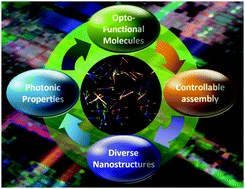Organic nanophotonics: from controllable assembly of functional molecules to low-dimensional materials with desired photonic properties
Abstract
Nanophotonics, which is mainly the study of the behavior of light–matter interaction at the wavelength scale, has developed into one of the most important branches in optics-related disciplines. Utilizing organic functional molecules as the building blocks of nanophotonic materials and devices has great potential due to the multiple advantages, including the molecular designability, good processability, tailorable properties, and so on. Small molecules exhibit a strong tendency to aggregate into low-dimensional structures through an assembly process. The morphologies of the formed products, which are tightly related to the stacking modes of the molecules, can be precisely controlled through the modulation of various intermolecular interactions. The optical properties of organic complex structures, assembled from one or more types of small molecules, show heavy dependence on the composition, distribution, as well as the topological structures, manifesting a strategy to acquire desired photonic properties via rational structural design and/or componential modulation. This tutorial review focuses on the relationship among various molecules, diverse structures and photonic properties, with emphasis on the controllable assembly processes to fabricate low-dimensional structures and assembly strategies to achieve requisite optofunctional properties.


 Please wait while we load your content...
Please wait while we load your content...